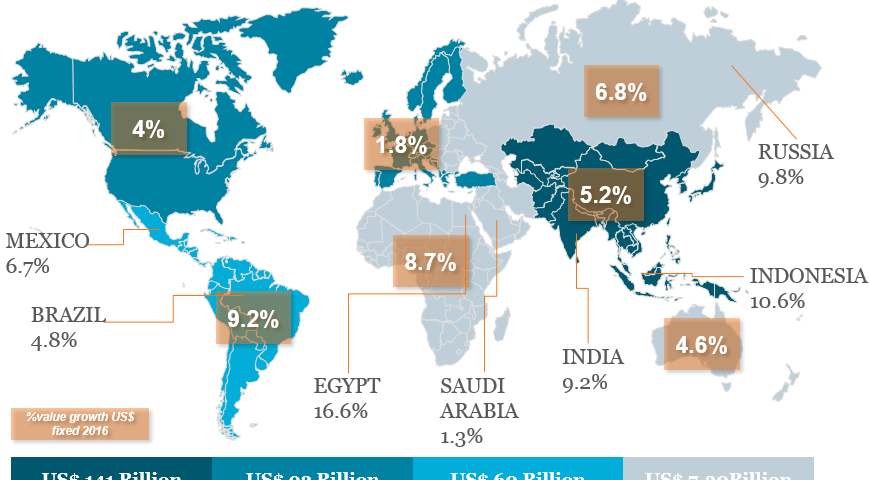By Nicholas Micallef, Senior Analyst – Beauty and Personal Care Research at Euromonitor International.
Euromonitor International’s 2017 edition reveals a strong beauty and personal care industry in 2016, with a respectable 5% growth. For the second consecutive year, the premium segment outperformed its mass counterpart, with nearly 6% growth.
Growth Shifts: US Solid, Emerging Markets Mixed Results of Falter and Recovery
At county level, Brazil and Russia have restored their place among the promising growth markets. While the economic situation improved in Brazil, brand owners also resorted to measures such as frugal innovation and promotional offers to keep demand intact. Meanwhile, Russia was boosted by local players, such as Natura Siberica and Faberlic, and higher spending in Russian high streets, as consumers shunned shopping destinations such as Paris and London, and spent less in travel retail.
India and Indonesia continued to drive growth in 2016, at 9.2% and 10.6%, while their market size nearly doubled over 2011-2016 to reach US$12 billion and US$4.6 billion, respectively. Projections point to similar dynamics, with India expected to suffer in the short-term from demonetisation, but is expected to recover fast as retailers facilitate cashless transactions.
Colour cosmetics rebuff spending cutbacks
At 7.2% growth, it was a stellar year for colour cosmetics. Dynamic brands fuelled category growth, including Nyx, Urban Decay and Kiko Milano, which grew via retail network expansion, supported by in-store digital technology to enhance the consumer experience. Winning brands are typically leveraging digital platforms to communicate their message.
Skin care slowed marginally to under 5%, largely the outcome of a slowdown in China. Other key categories, notably, fragrances and hair care, posted stronger growth in 2016 versus 2015, helped by improving disposable incomes in emerging markets.
Future looking more premium
BPC forecasts points to an increasingly premium future over 2016-2021, with a CAGR of 3.6%, compared to 2.4% in the mass segment. China and the US are predicted to contribute 54% of the US$20.3billion in absolute gains over the forecast period.
While global mass colour cosmetics and skin care remain stronger than the premium segment, predicted to addUS$6 billion and US$12 billion in absolute gains, respectively, the key regions of North America and Western Europe reveal a healthier outlook in the premium segment. Premiumisation is pushing mass brands in this direction, merely to survive in the marketplace, as more consumers seek the quality and results associated with premium formulations.
North America dominates scope for premiumisation
Asia Pacific leads premium BPC forecasts over 2016-2021, expected to generate US$6.6 billion in absolute gains. However, this amounts to just under half of the mass segment equivalent. Premium segment prospects are explained by the large demographic, as more consumers in East Asia trade up from the mass segment. Luxury is increasingly becoming more accessible in the form of smaller packs, but also, regional players such as AmorePacific making inroads in several Asian markets.
Nevertheless, North America conquers per capita expenditure in premium beauty, which is expected to top US$90 by 2021. The region’s premium beauty forecast absolute gains over 2016-2021 amount to US$5.8 billion, double the prospects in mass beauty. This makes North America ripe for the high-end prestige market such as personalised beauty, and upmarket small-batch niche labels. As premium beauty becomes deeply embedded, the competitive challenge lies not in the product quality, but in making it distinct and as individualised as possible.
Consumer megatrends reflected in industry dynamics
Evolving consumer lifestyles are key drivers behind the vigorous premium beauty. These dynamics stem from cross-industry megatrends, observed also in foods and apparel. Purchasing decisions are increasingly motivated by the quest for healthy living and “green” consumption. Moreover, as consumers seek “experiences” over “possessions”, they also consume less, and reallocate income to premium products, largely in view that these would better fulfil their needs and priorities. In turn, this is driving customisation and personalised beauty, reinforced by smart technology that is catapulting forward the desired lifestyles.
The pursuit of prevention and wellbeing is driving innovation beyond cosmetics. For example, Burt’s Bees entered beauty-from-within with protein shakes, while AB-Crew exploited the surfacing of athleisure beauty, to target active consumers with muscle-enhancing and recovery topical solutions.
Moreover, the resilient dermocosmetics segment is channelling innovation in this direction. For example, the make-up artist brand, Bobbi Brown, made the bold move to launch Bobbi Brown Remedies with pharma-inspired solutions and packaging. More novel for the beauty industry are formulations with live probiotics that claim to act on skin care issues by balancing the skin’s bacterial flora. Among the pioneers are Mother Dirt and YUN Probiotherapy, both of which take dermocosmetics to a new level.
Beauty devices continue to advance, with personalisation forming a crucial role in device innovation, in order to assist users develop daily habits, track results and use products that match their exact requirements. For example, Dermologica’s Breezometer, tracks pollution levels in the user’s environment, to recommend the best-suited Dermalogica product.
Premiumisation is driving standards across all levels. As standards improve, luxury becomes more accessible to ordinary consumers, while for the wealthy, this is more pronounced through personalised services, such as smart diagnostics. Whichever group consumers fall into, brand owners must embrace the fact that the purchasing process is increasingly knowledge-based and consumers more capable of distinguishing science from marketing. Going forward, the use of digital technology will become more sophisticated as augmented reality and artificial intelligence become mainstream. The end result, personalisation for all?
Read an extract of Nicholas’ presentation at in-cosmetics Global on Slideshare http://bit.ly/2omFQ4k.
Receive Euromonitor International’s Beauty and Personal Care insights in your inbox http://blog.euromonitor.com/.

